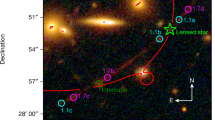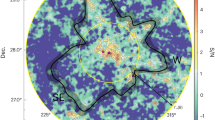Abstract
Most of the matter in the Universe is not luminous, and can be observed only through its gravitational influence on the appearance of luminous matter. Weak gravitational lensing is a technique that uses the distortions of the images of distant galaxies as a tracer of dark matter: such distortions are induced as the light passes through large-scale distributions of dark matter in the foreground. The patterns of the induced distortions reflect the density of mass along the line of sight and its distribution, and the resulting ‘cosmic shear’ can be used to distinguish between alternative cosmologies. But previous attempts to measure this effect have been inconclusive. Here we report the detection of cosmic shear on angular scales of up to half a degree using 145,000 galaxies and along three separate lines of sight. We find that the dark matter is distributed in a manner consistent with either an open universe, or a flat universe that is dominated by a cosmological constant. Our results are inconsistent with the standard cold-dark-matter model.
This is a preview of subscription content, access via your institution
Access options
Subscribe to this journal
Receive 51 print issues and online access
$199.00 per year
only $3.90 per issue
Buy this article
- Purchase on Springer Link
- Instant access to full article PDF
Prices may be subject to local taxes which are calculated during checkout





Similar content being viewed by others
References
Page, L. & Wilkinson, D. T. The cosmic microwave background. Rev. Mod. Phys. 71, 173–179 (1999).
Tyson, J. A., Valdes, F. & Wenk, R. Detection of systematic gravitational lens galaxy image alignments: mapping dark matter in galaxy clusters. Astrophys. J. 349, L1–L4 ( 1990).
Fahlman, G., Kaiser, N., Squires, G. & Woods, D. Dark matter in MS1224 from distortion of background galaxies. Astrophys. J. 437 56–62 (1994).
Squires, G., Kaiser, N., Fahlman, G., Babul, A. & Woods, D. A weak gravitational lensing analysis of Abel 2390. Astrohys. J. 469, 73–77 (1996).
Clowe, D., Luppino, G. A., Kaiser, N., Henry, J. P. & Gioia, I. M. Weak lensing by two z ∼ 0.8 clusters of galaxies. Astrophys. J. 497 61–64 (1998).
Hoekstra, H., Franx, M., Kuijken, K. & Squires, G. Weak lensing analysis of CL 1358+62 using hubble space telescope observations. Astrophys. J. 504, 636–660 ( 1998).
Mellier, Y. Probing the universe with weak lensing. Annu. Rev. Astron. Astrophys. 37, 127–189 ( 1999).
Gunn, J. E. A fundamental limitation on the accuracy of angular measurement in observational cosmology. Astrophys. J. 147, 61– 72 (1967).
Dyer, C. & Roeder, R. Observations in locally inhomogeneous cosmological models. Astrophys. J. 189, 167–175 (1974).
Miralda-Escudé, J. The correlation function of galaxy ellipticities produced by gravitational lensing. Astrophys. J. 380, 1– 8 (1991).
Blandford, R., Saust, A., Brainerd, T. & Villumsen, J. The distortion of distant galaxy images by large scale structure. Mon. Not. R. Astron. Soc. 251, 600–627 (1991).
Kaiser, N. Weak gravitational lensing of distant galaxies. Astrophys. J. 388, 272–286 (1992).
Villumsen, J. Weak lensing by large-scale structure in open, flat and closed universes. Mon. Not. R. Astron. Soc. 281, 369– 383 (1996).
Jain, B. & Seljak, U. Cosmological model predictions for weak lensing. Astrophys. J. 484, 560– 573 (1997).
Kaiser, N. Weak lensing and cosmology. Astrophys. J. 498, 26–42 (1998).
Kristian, J. On the cosmological distortion effect. Astrophys. J. 147, 864–867 (1967).
Valdes, F., Tyson, J. A. & Jarvis, J. F. Alignment of faint galaxy images: cosmological distortion and rotation. Astrophys. J. 271, 431– 441 (1983).
Mould, J. et al. A search for weak distortions of distant galaxy images by large-scale structure. Mon. Not. R. Astron. Soc. 271, 31–38 (1994).
Schneider, P. et al. Detection of shear due to weak lensing by large-scale structure. Astron. Astrophys. 333, 767– 778 (1998).
Wittman, D. et al. Big SPIE throughput camera: the first year. Proc. SPIE 3355, 626–634 ( 1998).
Castleman, K. R. Digital Image Processing 214 (Prentice Hall, Englewood Cliffs, New Jersey, 1979).
Fischer, P. & Tyson, J. A. The mass distribution of the most luminous x-ray cluster RXJ1347.5-1145 from gravitational lensing. Astron. J. 114, 14–24 ( 1997).
Gullixson, C. A., Boeshaar, P. C., Tyson, J. A. & Seitzer, P. The B j RI photometric system. Astrophys. J. Suppl. Ser. 99, 281–293 (1995).
Bertin, E. & Arnouts, S. Sextractor: software for source extraction. Astron. Astrophys. Supp. 117, 393–404 (1996).
Valdes, F. Resolution classifier. Proc. SPIE 331, 465 –472 (1982).
Tyson, J. A. in AIP Conf. Proc. Dark Matter (eds Holt, S. & Bennett, C.) 287 –296 (AIP Press, 1995).
Wittman, D. & Tyson, J. A. The shear correlation function out to 20 arcminutes. In Gravitational Lensing: Recent Progress and Future Goals (eds Brainerd, T. G. & Kochanek, C. S.) (ASP Conference Series, Astronomical Society of the Pacific, San Francisco, in the press).
Kruse, G. & Schneider, P. The non-gaussian tail of cosmic shear statistics. Preprint astro-ph/9904192 at 〈http://xxx.lanl.gov〉 ( 1999).
Tran, K. H. et al. The velocity dispersion of MS1054-03: a massive galaxy cluster at high redshift. Astrophys. J. 522, 39– 45 (1999).
Hu, W. Power spectrum tomography with weak lensing. Astrophys. J. 522, L21–L24 (1999).
Hamilton, A. J. S., Matthews, A., Kumar, P. & Lu, E. Reconstructing the primordial spectrum of fluctuations of the universe from the observed nonlinear clustering of galaxies. Astrophys. J. 374, L1–L4 (1991).
Peacock, J. A. & Dodds, S. J. Non-linear evolution of cosmological power spectra. Mon. Not. R. Astron. Soc. 280, L19–L26 (1996).
Ostriker, J. P. & Steinhardt, P. J. The observational case for a low density universe with a cosmological constant. Nature 377, 600–602 ( 1995).
Bahcall, N. A., Ostriker, J. P., Perlmutter, S. & Steinhardt, P. J. The cosmic triangle: revealing the state of the universe. Science 284, 1481–1488 ( 1999).
Turner, M. S. & Tyson, J. A. Cosmology at the millennium. Rev. Mod. Phys. 71, 145–164 (1999).
Frenk, C., White, S. D. M., Efstathiou, G. & Davis, M. Galaxy clusters and the amplitude of primordial fluctuations. Astrophys. J. 351, 10–21 (1990).
Acknowledgements
We thank W. Hu and J. Miralda-Escudé for help with theoretical predictions of several cosmological models. We also thank S. Gentile for artwork, and the staff of CTIO for their help with the BTC project and for their upgrading and maintenance of the delivered image quality of the Blanco telescope. Cerro Tololo Inter-American Observatory is a division of National Optical Astronomy Observatory (NOAO), which is operated by the Association of Universities for Research in Astronomy, Inc., under cooperative agreement with the NSF. Big Throughput Camera construction was partially supported by the US National Science Foundation.
Author information
Authors and Affiliations
Rights and permissions
About this article
Cite this article
Wittman, D., Tyson, J., Kirkman, D. et al. Detection of weak gravitational lensing distortions of distant galaxies by cosmic dark matter at large scales. Nature 405, 143–148 (2000). https://doi.org/10.1038/35012001
Received:
Accepted:
Issue Date:
DOI: https://doi.org/10.1038/35012001
This article is cited by
-
Indian spectroscopic and imaging space telescope (INSIST): An optics design trade-off study
Journal of Astrophysics and Astronomy (2023)
-
Glitches in time
Nature (2016)
-
Equatorial gravitational lensing by accelerating and rotating black hole with NUT parameter
Astrophysics and Space Science (2016)
-
Galaxy Alignments: An Overview
Space Science Reviews (2015)
-
Galaxy Alignments: Observations and Impact on Cosmology
Space Science Reviews (2015)
Comments
By submitting a comment you agree to abide by our Terms and Community Guidelines. If you find something abusive or that does not comply with our terms or guidelines please flag it as inappropriate.



